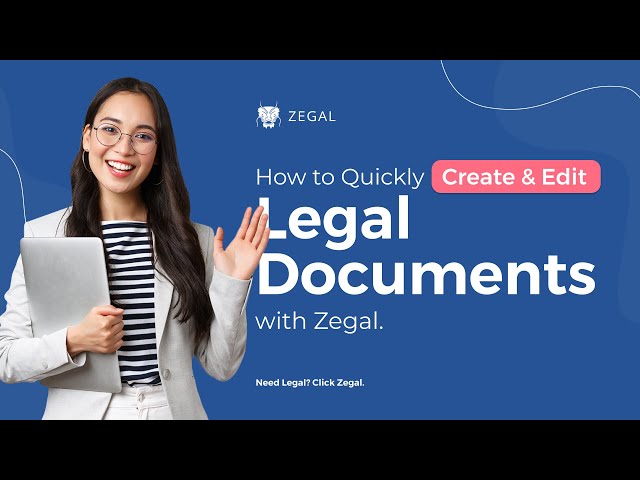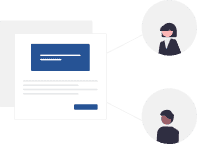How to generate a SaaS Agreement
What does SaaS stand for?
SaaS stands for Software-as-a-Service.
SaaS is becoming the predominant force in the software market, with examples including Zegal, Google’s Workspace applications, Netflix, and Dropbox.
What is a SaaS subscription agreement?
A SaaS (Software as a Service) agreement is a legal contract between a SaaS provider and a user detailing the terms and conditions for the provision of software services.
Like every legal document, the terms and conditions of a SaaS agreement outline the conditions where the agreement may terminate, which may occur naturally (after reaching the established date of the agreement) or in case of an infraction.
SaaS agreement checklist
A typical SaaS Agreement may include:
- Access rights and users: Who holds access to the software and the limitations to their access. Generally, it also outlines the penalties in correlation to unauthorised access.
- Data Ownership: Arranges the proprietorship over the collected data.
- License agreement: Clarifies the exact details concerning the limitations and rights of the client.
- The payment terms: EG, subscription type, service cost, discount prices and the date for payment.
- Termination and renewal: Outlines the conditions under which either party can terminate the agreement and a renewal clause for continuing the contract.
- Performance objectives: Information regarding service guarantees given by the provider.
- Confidentiality and intellectual property rights provisions: To prevent unauthorised usage and disclosure of the software or its features.
- Cancellation policy: Clarifies termination fees, conditions, and refund provisions.
- Limitation of liability: The amount of damage recovery a party may acquire from the other party in the event of an infraction.
When is a SaaS agreement used?
Traditionally, software was sold to businesses as a complete package and installed on servers within specific premises.
However, nowadays, companies can license the software instead of acquiring it outright.
With the advent of White Labelling, software companies began utilising cloud computing to provide access to software and technology. SaaS agreements are relevant in these scenarios.
SaaS agreements are typically employed in larger scale or more complex projects due to the heightened need for clarity regarding terms of use. A SaaS agreement will focus on governing costs, features, uptime, usage, and analytics.
By their nature, many SaaS applications will have users globally. While different levels of service may be offered, the basic terms and conditions under which these users access the application must be consistent.
General terms and conditions of Saas agreements
SaaS agreements provide clarity on the terms and conditions that govern the use of software services. These terms grant SaaS providers authority over their applications, offering legal safeguards for providers and users in disputes.
For SaaS companies and their clients, such agreements are foundational, outlining the obligations and rules customers must adhere to for continued access to the service.
These rules may include copyright limitations, dispute resolution methods, and interaction norms with fellow users. The conditions of use, once accepted, are legally binding.
Rights and responsibilities of subscribers and providers
Under a SaaS agreement, the provider must deliver services as specified, granting customers a license to use their software within agreed terms.
Customers are bound to use the software solely for its intended purposes, adhering to any restrictions or prohibitions. Beyond ensuring service continuity, providers offer support, maintenance, and updates to the software as necessary.
The precise content of the SaaS agreement varies based on the service and the parties entering the contract. However, the document should always provide a clear understanding of any expectations and liabilities.
A critical legal duty of the provider is to safeguard client information confidentiality, including a data protection policy for customer-supplied information.
Since customer data remains the customer’s property, SaaS providers must adhere to GDPR-compliant data processing standards.
SaaS Service Level Agreement (SLA)
A SLA or Service Level Agreement is a pact between the provider and the customer detailing responsibilities for service performance.
SLAs typically cover service details, quality measurement methods, uptime guarantees, compliance, penalties, maintenance, billing, and security provisions.
Typical SLA metrics are:
- Response time to requests and issues
- Support hours and channels for making help requests
- Limits on unscheduled downtime
These commitments must be measurable and reportable to customers upon request. If there is a failure on the platform or a breach of service levels, the vendor should provide a remediation plan.
Usually, there are penalties, such as service credits or refunds, for breaching an SLA. Most SaaS platforms will typically have a monthly service fee, which can be billed monthly or annually (often at a discount).
Data ownership in SaaS agreements
In SaaS agreements, the norms and regulations around data ownership are complex. But typically, the creator of the data retains ownership of it.
Thus, when customers generate or collect data hosted in the cloud, they maintain ownership, though the provider controls it.
Stakeholders are advised to meticulously review the SaaS SLA before agreeing to it. User data is valuable, and the agreement should detail how customers can recover theirs, especially if the provider faces bankruptcy.
Customers must be vigilant about their data protection and negotiate SaaS agreement terms that enhance the security of their information.
Warranties in a SaaS agreement
Software service vendors typically offer warranties, including non-infringement, virus-free operation, and performance guarantees tailored to the specific agreement and relationship.
Customers often have the chance to try the service before purchase, but in cases where pre-testing isn’t available, warranties incentivise customers and compel vendors to keep their services updated and legally compliant.
Warranties are crucial for providers to limit liability and prevent legal disputes.
Payment terms in a SaaS agreement
SaaS agreements typically use either monthly or term-based subscription models for payments.
Monthly subscriptions involve regular charges via electronic payments or credit cards, often allowing customers to cancel anytime without penalties, though some may offer annual or quarterly payment options.
Term subscriptions differ by setting payments for a fixed duration, typically 12 months, which the subscriber must commit to.
Renewal provisions of a SaaS agreement
SaaS contracts often last a year, requiring annual renewal. About 89% of providers incorporate auto-renewal clauses, giving customers time to evaluate the service’s value and decide on renewal.
Service delays can affect businesses reliant on SaaS solutions, which is why many agreements feature auto-renewal clauses. Should subscribers wish to end their contract before the auto-renew, they must notify the provider, usually 30 days in advance.
Rights of subscribers and producers to terminate
Providers can suspend or end services under certain conditions, typically due to breaches or unauthorised client cancellations. To protect their interests, subscribers can negotiate terms within the agreement to limit suspension rights to instances of serious violations.
Subscribers can also safeguard against immediate termination by including terms for negotiation or notice periods to rectify inadvertent breaches. For example, providers might agree to issue warning notices before taking action.
Alternatively, providers might reserve the right to make unilateral service changes without client consent, but customers can usually terminate the agreement if such changes materially impact them.
Providers aiming to retain customers might charge an early termination fee if a subscriber ends the contract prematurely to offset their investment and anticipated income.
Post-termination, providers usually must allow clients to retrieve their data, and the agreement may outline how a customer can transition to a new service.
SaaS software license agreement
Keeping track of each service’s licensing terms can be daunting for teams managing numerous SaaS applications.
SaaS differs markedly from traditional on-premise software; instead of a software copy installed on a server, SaaS operates in the cloud, resembling subscription services more than conventional licensed use, akin to end-user license agreements (EULA) within SaaS agreements.
Standard SaaS licensing models include:
- Per-user licensing: A subscription model where a fee is charged upfront for each user, often available in various tiers offering different levels of access.
- Usage-based licensing: Fees are based on the extent of service consumption, such as the number of transactions, reports, and data used over a period.
Beyond these models, SaaS providers are introducing varied licensing options like tiered pricing, feature-based pricing, active user pricing, open-source pricing, and monthly subscriptions.
Perpetual vs. SaaS Licensing
Unlike perpetual licenses, such as those once offered by companies like Microsoft, which grant indefinite software use, SaaS licenses are tied to the duration of the agreement.
They do not offer perpetual access; the license expires upon the agreement’s termination, making SaaS licenses renewable but time-limited.
Intellectual property rights in a SaaS agreement
Intellectual property encompasses patents, copyrights, and trademarks.
SaaS agreements typically include a clause acknowledging that the vendor retains ownership of the intellectual property in the service, software, and systems provided.
This clause confirms the provider’s exclusive ownership of the software, documentation, and other intellectual property included in the service.
Licensing allows subscribers to use the services, with the agreement clearly outlining usage restrictions and stating that any use beyond these restrictions violates the terms.
SaaS limited liability clauses
A limited liability clause protects SaaS vendors within their contracts, limiting customers’ ability to claim compensation for any damages incurred.
For example, if the software contains bugs or malfunctions temporarily, causing the client’s business to suffer losses, this clause prevents the client from seeking damages from the software provider.
SaaS vendors often include limited liability clauses in agreements to address the risks associated with their unique or evolving products. These clauses can sometimes disproportionately favour the vendor by reducing or negating their responsibility for any issues or damages caused by their services.
SaaS indemnification clauses
In licensing deals, indemnity is crucial and requires thorough examination.
Most commercial contracts, including SaaS agreements, feature an indemnification clause. This clause obliges the licensor to cover damages, often relating to third-party claims.
Indemnification provisions in commercial contracts impose a duty on the licensor to compensate for any losses arising from problems with the product or service.
For instance, if a licensed technology has a defect leading to a data breach, the indemnification clause mandates the licensor to handle associated legal costs or third-party damages.
While indemnification is standard in tech licensing, certain aspects of these clauses could introduce additional complications.
What are the risks associated with SaaS?
Engaging in software services via SaaS can present several risks:
- As these services are internet-based, they are inherently limited by network reliability. Any disruption in network service can lead to interruptions in the SaaS offering. Users may encounter issues like data bottlenecks and security vulnerabilities linked to their internet browsers.
- Customers lack control over the service’s support, performance, availability and privacy concerning their data stored by the SaaS provider. Often, clients depend on the provider’s adherence to ethical practices without having the means to influence the management or sharing of their data with other clients. The location of the provider’s servers might not be disclosed unless specified in the agreement.
- Should the provider become insolvent or bankrupt, subscribers risk losing access to their services.
- The process and expenses of migrating data to a SaaS system can be significantly high.
- Large providers might draft contracts heavily in their favour, including disclaimers for data loss, security breaches, service disruptions, or backup failures. They may limit their liability or the remedies available to clients for any loss suffered. Providers could also track the customer’s usage of the SaaS solution and utilise this data for third-party purposes.
Minimising and mitigating SaaS risks
Customers with significant negotiating power can mitigate SaaS-related issues through a robust agreement.
Should the vendor’s terms be fixed, subscribers must weigh their options carefully before committing. To reduce SaaS contract risks, consider:
- Select the appropriate service: Align the software with your business goals to lessen SaaS risks.
- Understand employee experiences: The technology your business uses significantly affects staff experiences. Collaborating with business managers who grasp your employees’ applications is crucial, enhancing understanding of their sentiments towards specific SaaS applications.
- Grasp your contractual commitments: The agreement with your SaaS provider involves more than cost; usage is equally critical. If the software doesn’t support enough simultaneous users, it may not meet your needs. Similarly, if an application is seldom used, the cost may not justify the investment. Consider features of the contract that you’re not utilising.
- Develop a software adoption plan: The last step in minimising SaaS risk involves setting clear expectations for software adoption ensuring employees know when and how to access services. Utilising roadmap templates can aid in making your workforce more productive by carefully evaluating the costs and benefits of SaaS.
Create a SaaS agreement template
Zegal is quick and straightforward to use. It’s legally binding, drafted by real lawyers and requires no legal knowledge to build.
Stay compliant with the Zegal template library
Zegal legal template are meticulously crafted with the precision of AI and the expertise of seasoned human lawyers, providing a unique blend of speed and reliability.
You can trust that Zegal agreements are legally sound and fully compliant with current regulations.
Whether you're a startup, SME, or a larger enterprise, Zegal contract management will automate and speed up your legal processes.
Using Zegal will reduce risk, save money, and improve efficiency. Let us take care of the paperwork so you can focus on running your business.
Don’t compromise on speed or compliance. Stay secure, compliant, and efficient with Zegal.






